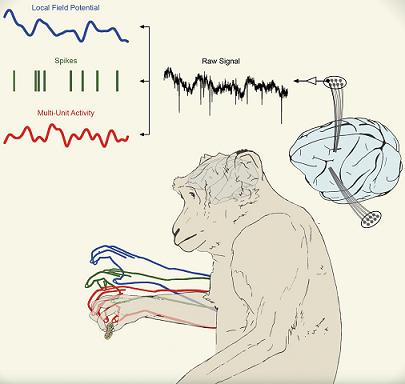Brain researchers at the Hebrew University have taken a new approach to deciphering brain activity that may enable the movement of natural or artificial limbs of paralyzed or amputated people

Neural activity in the premotor cortex of a monkey that contains information about the direction of the hand's reach and the shape of the grip. The most accurate information is obtained from the new method of measuring nerve cell populations (red); Measurement using the EEG method (blue) and measuring the activity of individual nerve cells (green). (Illustration: Sandrin Alon courtesy of the Hebrew University)
Neuroscientists have been interested for many years in understanding the relationship between brain activity and behavior, and especially between neural activity in motor areas of the cerebral cortex and hand movements. Beyond basic scientific questions, the research is of great practical importance because if a clear connection is found, it will be possible to help the paralyzed and amputated by building a device through which brain activity will activate muscles in a paralyzed limb or a robotic arm.
In an article recently published in the Journal of Neuroscience, Eran Stark and Prof. Moshe Ables, brain researchers from the Department of Physiology at the Hebrew University, report on an approach to measuring brain activity that does not suffer from many of the shortcomings of conventional approaches and guarantees a more reliable interpretation of brain activity.
Two main methods are currently used to measure the electrical activity in the brain. The first method is based on the EEG (electro-encephalogram) wave measured over the scalp, directly from the cerebral cortex (that is, its outer part) or from the inside of the brain; The second method is based on the activity of individual nerve cells in the cerebral cortex and is measured using intracerebral electrodes (very fine wires).
Each of the methods has advantages but also real technical disadvantages. In order to decode brain activity with sufficient precision to operate a robotic arm or a paralyzed limb, a large number of independent and stable measurements are needed from a relatively small area (in a person - about four square meters). None of the methods are optimal for doing this.
One of the disadvantages of using EEG is that adjacent electrodes measure almost the same activity, so the benefit of multiple electrodes is limited. Another disadvantage arises from the fact that most of the changes in the EEG wave occur after the movement begins and not before, as is required for controlling a paralyzed limb or a robotic arm.
As for the use of intracerebral electrodes, it turned out that over time, the brain responds to the presence of the recording wires through the formation of support cells similar to scarring after an injury, therefore a significant part of the activity of the individual cells is masked.
The approach taken by the Hebrew University scientists includes measuring the activity of all nerve cells located at a medium distance (about 100 to 200 micrometers) from the impression wire. In this way, independent activities from a large number of adjacent points are recorded. Slight damage to the brain tissue in the vicinity of the registration point almost does not affect the quality of the measurement. In addition, the measurement remains stable for a long time.
In the new study, monkeys were trained to take a variety of objects that were placed at different points. The act of taking requires coordination between the direction of the arm's extension and the grip of the fingers. Using up to sixteen fine wires, a recording was made from the monkeys' brains as they took the objects. It was found that with the help of recording the activities of nerve cell populations, as described above, it is possible to predict the direction of the reach and the type of grip that the monkey will perform with an accuracy of about 90%, and in some cases with an accuracy of more than 99%. The prediction error based on the measurement method demonstrated in the new study was two to three times smaller than the error resulting from prediction based on the other measurement methods.
The researchers believe that the new research is progressing towards deciphering the movement intentions of paralyzed or amputated people and paves the way for the production of better devices for translating brain activity into actual movements.
